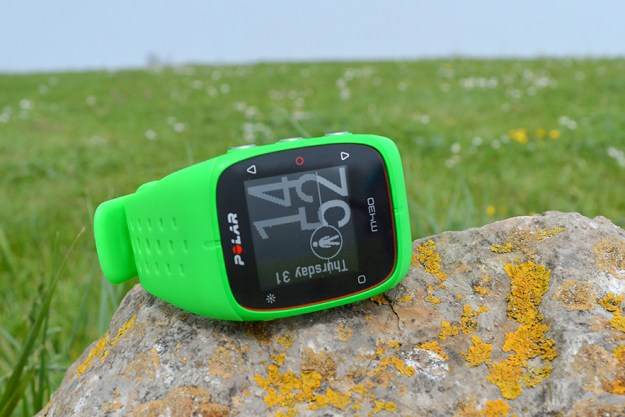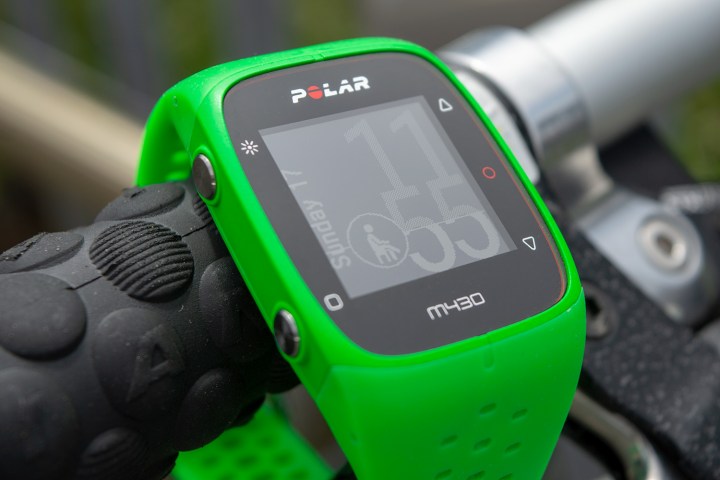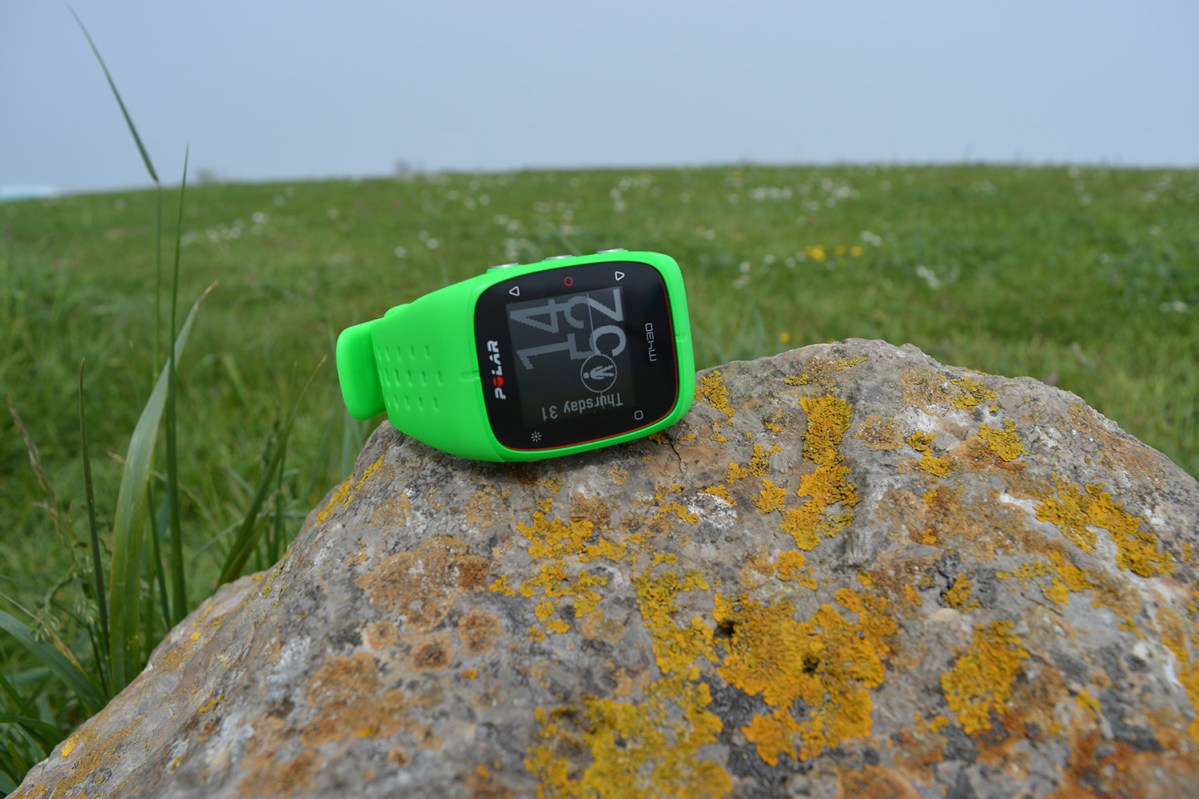
“What it lacks in smart functionality, the M430 makes up for with a suite of fitness tracking tools.”
- Excellent fitness stats
- Personal coaching for running
- Comfortable to wear
- Built-in GPS
- Heart rate sensor
- Outdated design
- Notifications are terrible
- Software lacking in certain areas
Modern shoppers are spoiled for choice when it comes to fitness trackers. Samsung, Fitbit, and Garmin all offer great devices for a wide variety of budgets. Even modern smartwatch brands are in on the action, as well, with the Apple Watch Series 3 providing good fitness tracking in a smartwatch shell.
But with all these options readily available, does a dedicated fitness tracker from industry veteran Polar stand a chance? With limited options for smartwatch-style notifications, but a huge suite of fitness tracking tools, the Polar M430 makes a compelling case for deserving a permanent home on your wrist. To truly test it of its competence, we spent a few weeks putting the M430 through its paces. Perhaps Polar’s place is more secure among its peers than we thought.
A retro design
It’s clear from a glance that Polar wasn’t intending the M430 to be a pillar of fashion. The design calls back to an older breed of GPS fitness trackers, and it’s not afraid to show it. If you’re looking for something that’s subtler and could pass for a regular watch, you may want to look at options like the Fitbit Versa or the Apple Watch Series 3.
The entire watch looks formed out of a single piece of elastomer, and while the straps can be removed and replaced, it’s not the same kind of easily-changeable wristband you’d find on the Polar A360. The way the elastomer forms around the top and bottom of the watch also means it’s impossible to lay on its back — which can make charging the device more of a pain. This is made even worse with the exceptionally short proprietary charging cable.
It’s clear from a glance that Polar wasn’t intending the M430 to be a pillar of fashion.
That said, this isn’t a device that’s meant to spend hours on a charger, and despite its plastic construction, it’s very comfortable to wear. Aside from the hardened top and bottom, the straps are soft and shouldn’t cause discomfort, even when tightened for physical activity — something Polar recommends for accurate heart rate tracking. During the day, it was easy to forget it was even there.
Bigger is better
The M430 is an enormous device, though. It’s 12 millimeters tall, and stands proud from your wrist while being worn. In other words, its size is notable on normal-sized wrists. Polar sent us its new green color, and while we like the aesthetic, that particular color makes the watch even more obvious. While wearing it as our out-and-about watch, strangers never hesitated to comment on the fact that it wasn’t exactly normal-looking. They weren’t wrong — it isn’t a normal watch. Though the black or white options would likely make it less of an eyesore, it’s still not a device that hides itself well.

The 1.3-inch display is running a monochrome 128 x 128 resolution, and you’ll also find buttons for navigation and the backlight on either side of the watch. If you’re looking for a colorful, touchscreen device, then you’ll definitely need to look elsewhere. Regardless, it’s clear and we had no trouble seeing it even in bright sunshine.
The back of the watch features an optical heart rate sensor, and while optical sensors get a bad rap, this one fared well enough with manual testing. However, it’s always wise to take optical sensor readings as a ballpark estimate. The M430 does sync with chest-bound heart rate sensors such as the Polar H10, but we found the watch’s sensor to be worthy enough to avoid spending money on an extra accessory. Polar recommends you tighten the M430’s strap before exercise to ensure the sensor can get a good reading, but this seems to be a precaution, as the sensor performed well for us even when held on a looser fitting — something we’ve noticed on other fitness trackers like the Suunto 3 Fitness.
The M430 is fully waterproof to a depth of 30 meters which makes it good for swimming. It’s worth noting, however, that the optical heart rate sensor loses some of its accuracy when used in water. That’s unlikely to be a huge issue unless swimming is your primary exercise — in which case it might be worth looking at another product better suited to swimming, like the Fitbit Ionic or any other waterproof Fitbit wearable.
Going with the Polar Flow
What the Polar M430 lacks in form, it makes up for in function. Pressing the middle button on the right side of the watch brings up a scrollable list of sports, which can be edited in the Polar Flow companion app for iOS and Android.
It didn’t take us long to realize the Polar Flow app is one of the engines that brings the best out of the M430. While the watch itself handles most of the everyday tasks you’ll need from a fitness tracker — standalone GPS tracking, rudimentary workout analysis, and support for timers and the Fitness Test (more on that later) — regular use of the app allows for more in-depth analysis of your fitness. Accessing the app’s dashboard gives an in-depth glance at your daily activity, broken down into various levels of intensity — so it’s easy to see how long you were sitting, walking, or running. Sleep-tracking also works smoothly, with both the app and M430’s display breaking down how restful your night was.
The experience isn’t a complete slam dunk, however, as some of the M430’s headline features aren’t available on either the app or the watch. For instance, users must access the Polar Flow website to set up running programs or edit pre-set templates for planned workouts. Access to some of the more interesting stats — like Recovery status — are also only available on the website.
It’s not a huge issue but juggling three platforms did get tiresome after a while, and having to boot up our PC to set up tomorrow’s exercises got annoying on occasion. It would be nice for the app to be able to handle more.
A digital personal trainer
Regardless of this minor inconvenience, there’s still some good functionality here. Polar’s running program trains users for a variety of events from 5K runs, all the way to marathons. The program guides you through every step of the process, filling your diary with runs, and basing their intensity and regularity on how often and how hard you run. The M430 also guides you through your run’s phases and works to keep your heart rate in an ideal target zone. It’s a good system, though we didn’t like having to set this up from the website client — this definitely seems like a feature that should be able to be accessed from the app itself.
During normal exercise, the M430 was just as helpful, showing off a variety of statistics including distance covered, current elevation, and speed. While not as much of a motivator as when it guided us through our different run phases, it’s still nice to have this basic data readily available during a workout.
The connectivity roller coaster
We had no issues with connectivity between the M430 and the Polar Flow at the start of the review, but some issues began to pop up later on. While syncing happened seamlessly in the background, the Polar Flow app seemed to experience issues with updating some of the dashboards, refusing to fill in the relevant data. This was made extra strange by other screens admitting that missing exercises had been done. Still, while annoying, this wasn’t a deal breaker.
It tracked distances extremely well, recording identical distances on multiple bike rides of the same route.
The inter-connectivity between Polar Flow and other apps we used was impressive, with workouts being automatically uploaded to Strava within seconds of syncing to the phone. If you’re not into Strava, the Polar Flow app also automatically sends workout data to Google Fit, MyFitnessPal, TrainingPeaks, and Nike+ Run Club.
The Polar M430 never had any issues with GPS tracking during activity, and it tracked distances extremely well, recording identical distances on multiple bike rides of the same route. While auto-pause and resume during activities are supported, it’s turned off by default on some activities, so you’ll have to manually pause and resume if you hadn’t checked beforehand. We would have liked to have seen auto-resume on by default, as changing the option involved far too much digging into the Sports Profiles options on the app — but the software did do a good job of assuming the distance we’d traveled after we remembered to resume a cycle roughly half a mile from where it was paused.
A fitness test that asks you to… relax
There’s also a fitness test built into the M430, and it’s not what you might expect. Instead of having you exercise and measuring your fitness based on your performance, Polar’s Fitness Test asks you to lie down and relax. Confused? Don’t be — it’s measuring your body’s ability to transport oxygen in your blood, with a higher VO2 Max representing a higher level of aerobic fitness. Polar recommends testing every month or so to see your progress.

Bizarrely, for a test that just involves lying down and relaxing, it’s very easy to fail. We found it was tripped up by moving too much, and had to retake the test on more than one occasion. Considering it only asked us to sit still, as opposed to running a mile or getting our heart-rate to a certain level, this wasn’t terribly annoying to have to do over again.
A “less-than-smart” watch
Polar included light smartwatch-style functionality, but it’s clear that the M430 wasn’t built with this in mind. You can choose between notifications with previews or without but either way, they’re not entirely great. The text is usually clipped, even on short notifications, and since dismissing one involves long-pressing the back button, it also takes far too long to dismiss them.
Outside of these notifications, there are no other smartwatch-style features, so don’t expect a music player or any real interaction with your phone. But if you’re not too fussed about those sorts of additions, then that won’t detract from the experience anyway.
Battery for days
The last thing you want when you’re mid-exercise is a notification your tracker just doesn’t have enough juice to make it all the way through. Thankfully, that isn’t something we noticed being an issue with the Polar M430. The 280mAh is small but since it’s only usually powering the tiny screen, we saw it last roughly a week on a single charge.
We saw it last roughly a week on a single charge.
Expect that lifespan to drop significantly if you’re also looking to use the heart rate monitor often, or if you exercise more than we did — roughly three times a week for an hour at a time. However, recharging the battery was quick, with the watch going from almost empty to completely full in about an hour. Thanks to this, topping up the battery before going out on a run was easy, with ten minutes of charge giving enough juice to keep it going into the next day.
Don’t expect to be able to charge it with any old cable though — for some reason, Polar moved away from the MicroUSB cable used in the Polar M400, replacing it with a proprietary cable. Not being able to plug any one of the MicroUSB cables around the house could become something of a bother, and the problem is especially annoying when traveling.
Warranty information
The Polar M430 costs $200 and you can buy it from Polar’s website, or from a host of retailers like Amazon. The M430 comes in a variety of colors, including White, Black, Peach, Green, and Blue.
Polar offers a two-year warranty for the Polar M430, which covers manufacturer defects.
Our Take
While we had our nitpicks with it, namely the need to use the Polar Flow desktop app and its touchy connectivity, there’s still a lot to love about the Polar M430 if you’re not put off by its visuals. With the capability of tracking a healthy helping of activities and exercises, the Polar M430 is waterproof, an excellent heart rate tracker, and a guidance tool, all thrown into one package that sits comfortably on your wrist.
It’s certainly not the best-looking device we’ve tested, and it’s lacking in the sorts of smartwatch features some might expect from a modern fitness tracker, but its Polar’s training and data services that really elevate the M430 into being the great fitness tracker it is.
Is there a better alternative?
Broadly put, it depends what you want from a fitness tracker. If you’re looking for a smartwatch and fitness tracker-hybrid, then there’s a lot of competition within the $200 bracket. Key amongst its competitors is the very capable Fitbit Versa, which offers similar fitness tracking capabilities, inside a much nicer looking shell. The Samsung Gear Fit2 Pro is another excellent choice within the same price bracket that provides great fitness tracking options and smartwatch-style functionality, all wrapped within an attractive package.
If you’re looking for something closer to a straight-up fitness tracker, then the Garmin Vivosmart HR+ provides a similar level of fitness polish and a comparable battery life.
If budget isn’t an issue and you want the absolute best fusion of a fitness tracker and a smartwatch, then there’s always the Apple Watch Series 3.
How long will it last?
The elastomer strap and casing around the watch unit feels solid, and after a month of constant use the M430 isn’t showing any signs of wear at all — we imagine it should last a good few years. Polar recommends keeping it clean by running it under the tap after every session.
In terms of software updates, the M430 runs on the same software as the majority of Polar’s other fitness trackers, and that ecosystem has seen its fair share of updates in the last year. We expect Polar to continue to improve the software experience as it goes.
Should you buy it?
Yes. While there’s been an effort made to blend the M430 with a smartwatch, it’s clear that the main focus of the tracker’s design has always been fitness-related, and it’s highly likely to stay that way.
If you’re the sort of person who wants a dedicated tracker that’s constantly keeping an eye on your performance, and don’t want to be bothered by notifications, then the Polar M430 is definitely for you. The Polar M430 delivers a great suite of fitness tracking tools and should remain useful for anyone a needs a good fitness tracker they’re unlikely to outgrow in a hurry.












